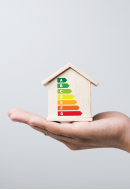Aerothermics: advantages, benefits and applications
Aerothermal energy, a sustainable and efficient option
Energy efficiency Renewable energy
Aerothermal systems are designed to provide heating in winter, cooling in summer and hot water all year round by extracting the ambient energy contained in the air by way of a thermodynamic cycle. Being considered a clean energy it has numerous benefits, for both you and the environment. Find out more about them below.

Heat pumps are becoming increasingly efficient and will play a key role in the decarbonisation process.
The transition towards a low-emission economy is possible, but to achieve this it is essential to develop more efficient energy carriers and end uses. Decarbonisation and electrification are an opportunity for creating wealth, generating green jobs and improving air quality —the goal of the European Union (EU), for example, is to achieve net carbon-free emissions by 2050—. The challenge, therefore, concerns the energy sector in particular, but also society in general, because this process will be vital in combating climate change.
The electrification of transport and residential heating, and the production of electricity — electrical self-consumption — via renewable energies will form a key part of the road map to be followed by the energy sector for decarbonising the economy. It is here where clean alternatives come into play, such as wind energy, photovoltaic energy, hydroelectric energy, green hydrogen, hybrid energy and aerothermics. Let's now find out a little bit more about the latter.
Aerothermics and the demand for heat. Applications
Aerothermal systems are heat pumps that extract the ambient energy contained in the air via a thermodynamic cycle for providing heating in winter, cooling in summer and hot water all year round. Electric heat pumps have extremely high potential —they are far more efficient than conventional boilers— and will therefore play a key role as an element of change when it comes to electrifying and decarbonising heat demand.
In Europe, for example, the use of heat represents 50% of end user demand for energy. Within that use, heating and domestic hot water (DHW) in buildings represent over 60% of heat requirements. Industrial thermal processes add around 30% and cooling, more important in the south than in the north, only 2%.
How aerothermal energy works. Heat pumps
The latest electric heat pumps are a very efficient technology, so much so that the regulators consider them to be renewable. The basic reason for this is that it is based on a thermodynamic cycle capable of extracting heat from the outdoor air thanks to the use of refrigerants.
How does aerothermal heat pump work?
Indoor unit
Device located inside the building that heats, cools and stores water that is distributed for renewable heating, cooling and hot water.
Outdoor unit
Heat pump installed outside the home to extract energy from the ambient air. It is slightly larger than an air conditioning machine.
Heating
Radiators, underfloor heating.
Cooling
Fan coils, underfloor heating.
Hot water
Taps.
 SEE INFOGRAPHIC: How does an aerothermal heat pump work? [PDF] External link, opens in new window.
SEE INFOGRAPHIC: How does an aerothermal heat pump work? [PDF] External link, opens in new window.
The refrigerants, which are undergoing constant development, are one of the key factors in heat pump performance. The latest most extensively used refrigerant in these pumps is R32, which reaches temperatures of up to 70ºC and is capable of improving efficiency. Others are also under development, such as R-290 (propane), R-744 (CO2) and the nano fluids.
A heat pump's performance depends both on the input (outside) and output (inside) temperatures. The most widely adopted thermal distribution systems are, therefore, the low temperature ones, such as underfloor heating and cooling. Its use for DHW or for high-temperature radiators provides a lower performance, although it must be said it is much higher than that of conventional boilers. To work, a heat pump requires the following components:
![]() Compressor
Compressor
Its job is to transform electrical energy and raise the pressure of the refrigerant fluid.
![]() Condenser
Condenser
This component condenses the refrigerant, which is transformed from a gas to a liquid by the heat exchanger.
![]() Expansion valve
Expansion valve
This device generates a high load loss by reducing the temperature to cause the refrigerant fluid to expand.
![]() Evaporator
Evaporator
This element causes the refrigerant fluid to evaporate. The heat is then absorbed and the cycle restarts.

Efficient houses
How to make your house a more sustainable one?

Home automation
The smart home: present or future?

Efficiency in buildings
Eight steps towards sustainable construction.
The advantages and disadvantages of aerothermics
Aerothermics provides numerous benefits, not only for the private user, but also for society as a whole, and it is for this reason that the majority of new-build housing is fitted with this type of systems:
![]() It offers a high level of efficiency and performance.
It offers a high level of efficiency and performance.
![]() It helps reduce emissions and energy consumption, thereby contributing to the Sustainable Development Goals (SDGs).
It helps reduce emissions and energy consumption, thereby contributing to the Sustainable Development Goals (SDGs).
![]() It helps users to make savings on their bills after the initial outlay and it is useful all year round.
It helps users to make savings on their bills after the initial outlay and it is useful all year round.
 It is convenient, safe and reliable as it does not depend on fuel supplies or complex maintenance procedures. Furthermore, its functional design is relatively simple.
It is convenient, safe and reliable as it does not depend on fuel supplies or complex maintenance procedures. Furthermore, its functional design is relatively simple.
![]() It improves air quality at local level by eliminating completely emissions of the NOx (nitrogen oxide) and SOx (sulphur oxide) particles produced by combustion boiler-based systems.
It improves air quality at local level by eliminating completely emissions of the NOx (nitrogen oxide) and SOx (sulphur oxide) particles produced by combustion boiler-based systems.
![]() Public bodies are promoting measures to encourage the development of electrification via, for example, tax incentives.
Public bodies are promoting measures to encourage the development of electrification via, for example, tax incentives.
All of these benefits face the obstacles that the introduction of heat pumps face presently and which we examine below:
- Domestically, a sufficient outdoor space is required. although this is becoming increasingly smaller thanks to technological advances. Aerothermics generators also need an indoor space for the heat exchanger and the DHW storage system. In addition, these generators give off heat in the summer, meaning they require about 3 metres of free space around them.
- The high price of the machines, as well as the cost of installing the new equipment, make the changeover cost greater than that of fitting a conventional boiler plus an air-conditioning system for the entire home. However, this is offset by a lower operating cost.
- Traditionally, air-source heating is associated with: thermal discomfort — in splits there can be an excess of air flow speed and a dry atmosphere —, low inertia — systems that instantly stop heating when turned off — and noise nuisance. However, the use of aerothermics with underfloor heating and cooling is a perfect combination that makes it possible to take full advantage of all of this technology's capabilities (a warm floor in winter and cool floor in summer).
Energy that changes lives
At Iberdrola España we believe that to inspire you have to tell stories. Stories that change lives.
Discover the webseries Energy that changes lives, created to share Iberdrola's inspiring stories in the most diverse corners of Spain. Find out how clean energy helps children with cerebral palsy, the neighbourhood of an inclusive education school and a sustainable vineyard from Concha, Elvira and Miguel.





